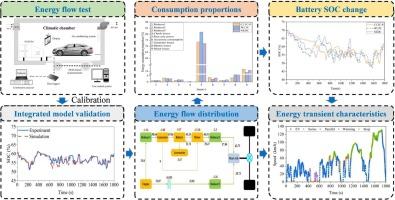混合动力汽车不同行驶周期能量流分布及暂态特性试验与仿真相结合研究
IF 5.4
3区 工程技术
Q2 ENERGY & FUELS
引用次数: 0
摘要
能量流分析是提高混合动力汽车效率的关键。基于实验数据,建立了p3架构并联混合动力汽车的综合仿真模型,并对其在世界轻型车测试周期(WLTC)、中国轻型车测试周期(CLTC-P)和新欧洲驾驶周期(NEDC)下的能量流分布和瞬态行为进行了评估。总体结果显示,WLTC、CLTC-P和NEDC的油耗分别为每百公里5.37升、4.28升和4.69升。尽管WLTC的总能源需求较高,但在三个循环中,动力传动系统的总损失是最低的,并且WLTC和NEDC下的发动机工作点集中在中低地图区域,与较好的燃油经济性相一致。电机效率等级为CLTC-P >; NEDC >; WLTC,反映了WLTC下负载和转速变化更快。在WLTC中,电池的充电状态下降得最快,低速时主要是电力推进,随着速度的增加,过渡到并联运行。这些发现为校准控制策略和提高混合动力汽车的能源利用率提供了经过验证的、针对特定周期的见解。本文章由计算机程序翻译,如有差异,请以英文原文为准。

Integrated experimental and simulation study on energy flow distribution and transient characteristics of hybrid electric vehicles across varied driving cycles
Energy flow analysis is pivotal for improving hybrid electric vehicle (HEV) efficiency. In this study, an integrated simulation model for a P3-architecture parallel HEV was developed and calibrated with experimental data, and energy flow distribution and transient behavior were evaluated across World Light Vehicle Test Cycle (WLTC), China Light-Duty Vehicle Test Cycle (CLTC-P) and New European Driving Cycle (NEDC). Headline results show fuel consumption of 5.37, 4.28 and 4.69 L per 100 km for WLTC, CLTC-P and NEDC, respectively. Despite the higher total energy demand of WLTC, aggregate drivetrain losses are the lowest among the three cycles, and engine operating points under WLTC and NEDC cluster in low to medium map regions that are consistent with better fuel economy. Motor efficiency ranks CLTC-P > NEDC > WLTC, reflecting the more rapidly varying load and speed under WLTC. The battery state of charge declines most rapidly in WLTC, with propulsion predominantly electric at low speeds and transitioning to parallel operation as speed increases. These findings provide validated, cycle-specific insights for calibrating control strategies and improving energy utilization in HEVs.
求助全文
通过发布文献求助,成功后即可免费获取论文全文。
去求助
来源期刊

Thermal Science and Engineering Progress
Chemical Engineering-Fluid Flow and Transfer Processes
CiteScore
7.20
自引率
10.40%
发文量
327
审稿时长
41 days
期刊介绍:
Thermal Science and Engineering Progress (TSEP) publishes original, high-quality research articles that span activities ranging from fundamental scientific research and discussion of the more controversial thermodynamic theories, to developments in thermal engineering that are in many instances examples of the way scientists and engineers are addressing the challenges facing a growing population – smart cities and global warming – maximising thermodynamic efficiencies and minimising all heat losses. It is intended that these will be of current relevance and interest to industry, academia and other practitioners. It is evident that many specialised journals in thermal and, to some extent, in fluid disciplines tend to focus on topics that can be classified as fundamental in nature, or are ‘applied’ and near-market. Thermal Science and Engineering Progress will bridge the gap between these two areas, allowing authors to make an easy choice, should they or a journal editor feel that their papers are ‘out of scope’ when considering other journals. The range of topics covered by Thermal Science and Engineering Progress addresses the rapid rate of development being made in thermal transfer processes as they affect traditional fields, and important growth in the topical research areas of aerospace, thermal biological and medical systems, electronics and nano-technologies, renewable energy systems, food production (including agriculture), and the need to minimise man-made thermal impacts on climate change. Review articles on appropriate topics for TSEP are encouraged, although until TSEP is fully established, these will be limited in number. Before submitting such articles, please contact one of the Editors, or a member of the Editorial Advisory Board with an outline of your proposal and your expertise in the area of your review.
 求助内容:
求助内容: 应助结果提醒方式:
应助结果提醒方式:


